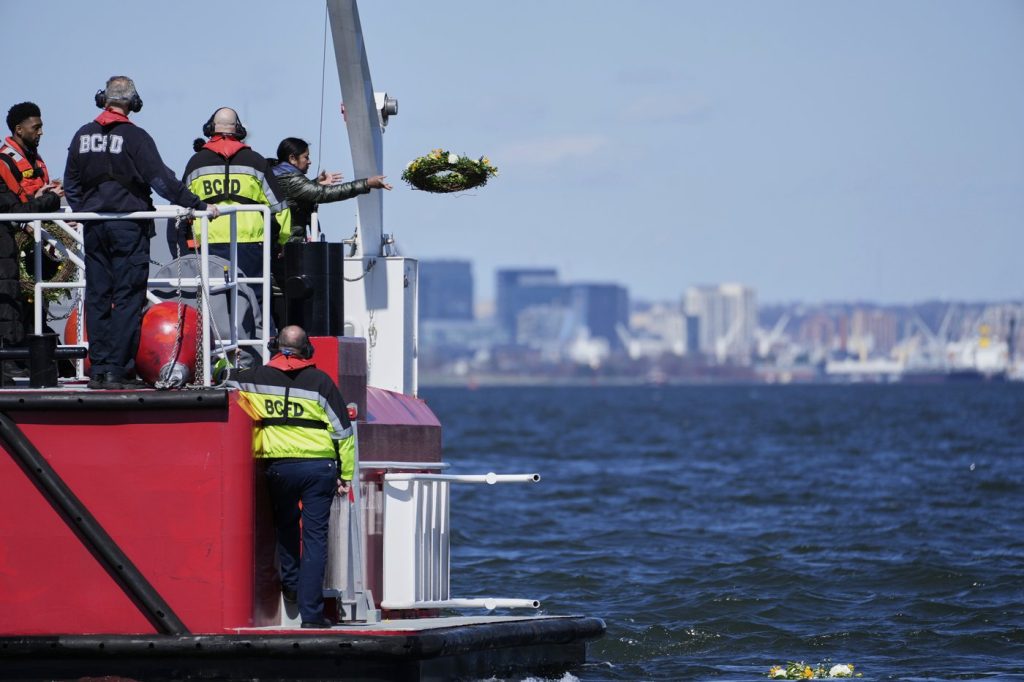BALTIMORE (AP) – One year after the tragic collapse of the Francis Scott Key Bridge in Baltimore, Maryland officials honored the six construction workers who lost their lives in the disaster. The bridge, which was undergoing repairs due to potholes, buckled beneath the crew while a massive cargo ship, the Dali, struck one of the supporting columns, causing catastrophic damage late at night on March 26, 2024. Baltimore Mayor Brandon Scott emphasized the importance of remembering those who perished during a recent commemorative ceremony.
In the moments leading up to the disaster, police managed to stop traffic on the bridge but did not have the time to inform the overnight roadwork crew. The incident resulted in significant repercussions, including the closure of the Port of Baltimore for several months as debris blocked its primary shipping channel. Following a challenging recovery period in the latter half of 2024, the port showed signs of rebounding, though ongoing tariff issues imposed by the Trump administration now pose a threat to its progress.
Federal investigators raised concerns regarding the Maryland Transportation Authority for failing to assess and address the Key Bridge's vulnerability to ship strikes, an oversight that has become increasingly significant given the evolution of maritime shipping since the bridge's original opening in 1977. Meanwhile, Maryland drivers have faced increased traffic congestion as alternate routes became heavily utilized after the bridge's closure, impacting port-oriented industrial communities on both sides of Baltimore.
The catastrophe was first brought to the attention of Maryland Governor Wes Moore at approximately 2 a.m. on March 26, 2024. He recalled the moment he received the call, expressing disbelief at the news of the Key Bridge’s destruction. The governor quickly grasped the magnitude of the tragedy as he learned that six workers, primarily Latino immigrants, had been filling potholes when the bridge collapsed beneath them after being struck by the Dali, which had suffered a power failure.
In the wake of the disaster, the community gathered to witness the recovery efforts. It took 11 weeks to reopen the main shipping channel to the Port of Baltimore, a feat that Governor Moore attributed to the collaborative efforts of local, state, federal, and military leadership. On the tragedy's one-year anniversary, city and state leaders participated in a wreath-laying ceremony to pay tribute to the victims. Families of the deceased traveled on the city’s fireboat to the site of the collapse, where they tossed wreaths of flowers into the water in remembrance of their loved ones.
A new replacement bridge is in the planning stages, with estimates for completion set for 2028. Officials revealed designs for Maryland’s first cable-stayed bridge, projected to cost around $1.7 billion, with Congress agreeing to fund the entire project. The new structure will incorporate advanced pier protection technology, addressing the increasing size of cargo ships and ensuring greater clearance height. Demolition of the remaining remains of the old structure is scheduled to take place in spring 2025.
Despite the challenges imposed by the tariffs, the Port of Baltimore reported that 2024 was one of its most successful years, handling 45.9 million tons of cargo. In a statement, Daraius Irani, chief economist at Towson University's Regional Economic Studies Institute, deemed the port's rebound as “sort of a miracle.” However, he cautioned that potential tariff impacts could lead to reduced revenue due to decreased imports from key partners like Mexico, Canada, and China.
The National Transportation Safety Board is still investigating the collapse, with a final report expected by fall 2025. Preliminary findings indicate a loose cable on the Dali might have contributed to the ship’s power loss prior to the accident. Additionally, the FBI has launched a criminal investigation into the circumstances surrounding the collapse, though there have been no recent updates released.










